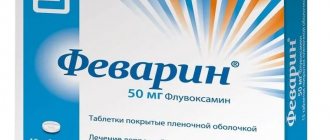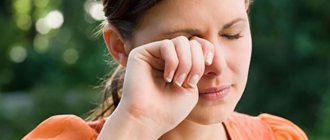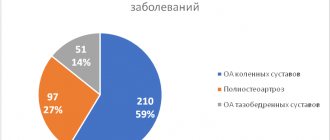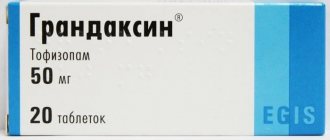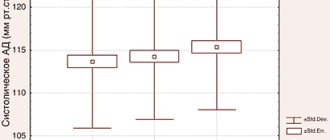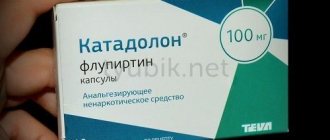Atarax
Atarax (INN hydroxyzine) is a tranquilizer from the Belgian pharmaceutical company UCB Pharma, SA. It was developed in the mid-50s of the last century and became the world's first non-benzodiazepine tranquilizer. He laid the foundation for a new class of drugs called ataractics. Largely thanks to Atarax (and only later - Viagra), a small pharmaceutical company at that time, which received a license to distribute the drug in the United States, grew to become a global giant and industry leader.
As a tranquilizer, Ataracas exhibits anxiolytic (suppresses anxiety) and sedative effects. In addition to this, the drug has an antihistamine (blocks histamine H1 receptors), m-cholinergic blocking (inactivates central m-cholinergic receptors) and antiemetic effects. It is important that pathological dependence does not develop to the drug. The pharmacological effect develops 20-30 minutes after the active substance enters the gastrointestinal tract. The drug normalizes cognitive functions (memory, mental performance, attention). Relaxes striated and smooth muscles. Dilates the bronchi. Has an analgesic effect. Suppresses the release of digestive enzymes into the lumen of the stomach. Reduces itching in allergic manifestations and dermatological diseases (dermatitis, eczema). With a long course of medication, after the end of taking the drug, withdrawal syndrome does not develop and there is no deterioration in cognitive activity.
A polysomnographic study in patients suffering from insomnia and anxiety disorders demonstrates a significant increase in sleep duration and a decrease in the number of episodes of awakenings at night after taking a single dose of Atarax. A decrease in muscle hypertonicity with increased anxiety has been demonstrated when taking Atarax at a dose of 50 mg three times a day. The drug is well absorbed from the gastrointestinal tract: its maximum plasma concentration is recorded two hours after oral administration. The bioavailability of hydroxyzine is 80%. Penetrates through the BBB, metabolic products enter breast milk. The half-life is 14 hours. The side effects inherent in the drug are mainly associated with the anticholinergic effect: hyposalivation, difficulty urinating, constipation, spasm of accommodation. Atarax is incompatible with ethanol, so during the medication course you should refrain from consuming ethanol-containing products. When taking the drug, it is necessary to take into account that hydroxyzine can slow down the reaction rate and impair concentration. Atarax enhances the effect of drugs that suppress the activity of the central nervous system: opioid painkillers, tranquilizers, barbiturates, sedatives. If it is necessary to combine them, you should be especially careful when choosing drugs.
Can antipsychotics be prescribed to children?
Inappropriate and unnecessary
Unfortunately, I often notice that the number of antipsychotics prescribed by psychiatrists for other purposes is growing, especially among children receiving government assistance in psychoneurological dispensaries and psychiatric hospitals. However, it is worth reminding antipsychotic drug lovers that psychotic disorders (psychoses such as schizophrenia) usually arise in adulthood and affect only a small proportion of children and adolescents. However, off-label antipsychotics most often target aggressive and disruptive behavior associated with attention deficit hyperactivity disorder (ADHD). What's really concerning now is that many of these antipsychotic prescriptions come amid emerging evidence that there are serious side effects that may be much more severe in children than in adults taking antipsychotics.
Catch up and overtake America
We still lag behind America in treating children with antipsychotics; we have practically only one antipsychotic approved for children and adolescents - risperidone, while the United States already has five. Indeed, the FDA has approved five drugs—risperidone, aripiprazole, olanzapine, quetiapine, and paliperidone—for the treatment of adolescents ages 13 to 17 years. I note that there is bureaucracy in all countries and it will take more than one year to allow the use of a particular drug, while evidence-based medicine has already gone far ahead, for example, judging by scientific publications, agomelatine can be prescribed to children, but is not allowed by protocols and standards approved by the Ministry of Health. A simple conclusion suggests itself: what if we forget about neuroleptics altogether and try to treat mentally ill children with drugs of other classes, for example, NMDA receptor blockers, such as rimantadine or amantadine, of course, if there are indications (tension, excitement, etc.), fortunately The Ministry of Health has allowed these medications to be given to people suffering from influenza A.
Should autism be treated with antipsychotics?
The FDA has approved risperidone and aripiprazole for the treatment of "behavioral problems associated with autism spectrum disorder" in children aged five to six years (aripiprazole is not yet approved in our country to prescribe aripiprazole to children, so no psychiatrist, especially in the public health system, will will prescribe your child aripiprazole, which has far fewer side effects than risperidone. The question is, are our children any worse than American children? Both drugs have been found to reduce irritability, aggression, self-harm, tantrums and mood swings in children with autism In one of the largest studies to date, risperidone reduced behavioral symptoms and reduced the rigid interests and repetitive behaviors typical of autism, but did not have the same effect as aripipiprazole on social and communication deficits, one of the core symptoms of autism.
Antipsychotics are not prescribed for ADHD and aggressive behavior in children
Doctors often prescribe antipsychotics to children and adolescents with conduct disorder, oppositional defiant disorder, or ADHD, even though the drugs are not approved to treat these conditions. In a review of eight randomized controlled trials conducted from 2012 to 2008, researchers concluded that modern antipsychotic drugs slightly reduced aggressive tendencies in children with disruptive behavior disorder, but their effects were only small. A review of the off-label use of these antipsychotics found that the evidence supporting their effectiveness in children newly diagnosed with ADHD was "low or very low."
Who needs it?
From 2002 to 2009, prescriptions for atypical antipsychotics increased 65%, from 2.9 million to approximately 4.8 million. According to a 2012 study published in JAMA Psychiatry, a staggering 90% of these prescriptions are off-label. ADHD and disruptive behavior disorders account for about 38% of all antipsychotic medications in children and adolescents.
Side effects of new antipsychotics
Modern antipsychotics have been called “atypical” to distinguish them from first-generation antipsychotics (classical antipsychotics such as haloperidol and aminazine). Initially, new antipsychotics were positioned as a safer alternative to their predecessors. However, it is now clear that atypical antipsychotics are associated with a variety of serious side effects, such as weight gain, diabetes, high cholesterol and cardiovascular disease. In a study of 116 children with early-onset schizophrenia who took risperidone, they gained an average of 2 kg. after taking the medication for eight weeks, while children taking olanzapine gained an average of 3 kg, prompting a safety review board to stop taking olanzapine early. Children taking the new antipsychotic medications are also three times more likely to develop type 2 diabetes than children not taking these medications. In addition, both classes of antipsychotics carry a risk of tardive dyskinesia, a neurological disorder that causes involuntary movements of the facial muscles. A 2008 study found that this neurological disorder occurs in approximately 4% of patients taking atypical antipsychotics, compared with 5.5% taking classic antipsychotics.
Other indications
Grandaxin is effective not only for VSD, but also for neuroses, as well as other similar conditions. Indications include:
- alcohol withdrawal;
- premenstrual, menopausal period;
- mental maladjustment;
- mild depression;
- conditions accompanied by muscle asthenia and atrophy, when muscle relaxant anxiolytics are unacceptable for use.
The drug is a daytime tranquilizer. It does not cause addiction or withdrawal symptoms.
An important property of Grandaxin is the relief of panic attacks. This is a feeling that occurs suddenly or under the influence of a stressful situation. Accompanied by a strong feeling of fear and vegetative disorders.
The concepts of VSD and panic attack are closely related: the attack is a kind of exacerbation of neurocirculatory dystonia. Therefore, therapy for these conditions follows a similar plan.
Prevention of infection
In children, worm prevention is carried out to reduce the risk of infection after contact with sick animals or people.
Basic measures to protect against infections include:
- washing hands with soap and water after visiting the toilet, public places, transport, contact with animals and outdoor games;
- pharmacological prevention of taking small doses of medications if a family member is infected;
- compliance with hygiene rules;
- proper heat treatment of fresh meat products and fish;
- boiling drinking water;
- exclusion of swimming in open waters;
- early diagnosis and treatment of infestations in domestic animals;
- sanitization of premises from flies, mosquitoes and other blood-sucking insects.
Infecting a child with parasites can negatively affect his health and delay the child's development. To reduce the risk of infection, you need to follow preventive and hygiene measures. When treating parasites, medications are needed, which are prescribed by the doctor after examining the child and receiving test results.
Features of use
Grandaxin is taken 1-2 tablets 1 to 3 times a day. The course of treatment is based on the severity of the manifestations and is prescribed exclusively by a doctor. A maximum of 300 mg of the drug per day is allowed.
Like any medicinal component, Grandaxin can lead to adverse reactions and intolerance by the body. They are manifested by the following violations:
- allergic rash and itching;
- pain and increased muscle tone;
- labored breathing;
- irritability and agitation, sleep disturbance, clouding of consciousness, headaches, exacerbation of epilepsy.
In case of an overdose of the drug, the development of a coma and breathing problems, depression of the central nervous system is possible.
Grandaxin should not be used for obsessive states and persistent psychoses. This will lead to a suicide attempt and increased aggression.
If you are allergic to lactose, the drug is also contraindicated, since each tablet contains about 90 mg of this substance.
The drug is not prescribed for respiratory disorders.
The drug should not be prescribed in the first 3 months of pregnancy and during breastfeeding.
The drug is prescribed with caution to patients with epilepsy, personality disorders and organic damage to the central nervous system, as well as elderly people, patients with mental retardation and decreased kidney function.
When the drug enters the intestines, it is quickly absorbed. Its highest concentration in the blood appears after a few hours. The active ingredient is not concentrated in the body. Most of it is excreted in urine, and a small amount is excreted in feces.
Grandaxin has some peculiarities of contact with other drugs. Its combination together with certain immunosuppressants (tacrolimus), as well as with cyclosporine, increases their accumulation in the blood.
Grandaxin enhances the intensity of the action of psychotropic drugs: sedatives, hypnotics and antidepressants.
In turn, its intensity of impact is increased by antihypertensive drugs, and accumulation in the blood is intensified by antimycotic drugs.
The combined use of Grandaxin and antacids reduces its absorption.
Anxiolytic mitigates the toxic effects of alcohol-containing drinks on the central nervous system. But its parallel use with these liquids, barbiturates, antiepileptic drugs, nicotine reduces its effectiveness.
How the drug works
When treated with Grandaxin, there is no drowsiness or lethargy. Moreover, it moderately increases mental and motor activity, stimulates mental activity, and provides a surge of strength and energy.
The drug does not cause muscle relaxation, eliminates the feeling of fatigue and increases performance. It returns sound and healthy sleep, but there is no lethargy or drowsiness during the day. In general, this drug does not have the side effects that are inherent in many tranquilizers.
Taking Grandaxin for VSD provides a vegetative stabilizing effect.
Our autonomic system regulates the activity of internal organs, as well as blood vessels. It consists of the sympathetic and parasympathetic divisions. If the balance in their work is disturbed, there is, accordingly, a failure in the regulation of the work of those systems for which they are responsible. Such violations can manifest themselves in different ways:
- tachycardia, pain and compression in the heart area;
- difficulty breathing, shortness of breath, feeling of lack of air;
- feeling of a lump in the throat;
- sweating, low-grade fever;
- redness of the skin, feeling of heat;
- headache, dizziness;
- asthenia, malaise;
- fear of death or concerns about one's health.
A similar symptom complex is a manifestation of vegetative-vascular dystonia.
Grandaxin helps to establish a synergistic effect of both parts of the autonomic nervous system, eliminates most symptoms of VSD, relieves apathy, anxiety, phobias and obsessive thoughts.
Description
Grandaxin is an anxiolytic drug or tranquilizer. Produced in 50 mg tablets. They have a round and flat shape, the color range varies from white to grayish. On one side there is a dividing line, on the other there is the Grandax logo.
The tablets are placed on a blister that holds 10 tablets. There are 2 or 6 pieces in a package.
The active substance of Grandaxin is represented by tofisopam. It is obtained by an atypical chemical modification of the diazepam molecule. Tofisopam belongs to the group of benzodiazepines and exhibits the properties of tranquilizers, but has some peculiarities.
Manifestations of various types of parasites
There are a large number of parasites that feed on the human body. Each of them affects different internal organs and has individual symptoms.
- Enterobiasis is caused by pinworms. A characteristic symptom of the disease is severe itching of the skin in the anal area, which intensifies at night.
- Ascariasis can cause fever, dry cough and allergic reactions. When infected, the child loses weight. At an advanced stage, jaundice, pancreatitis and intestinal obstruction may develop.
- Trichuriasis causes anemia and goiter. The stool is loose, the child is lethargic.
- Urogenital schistosomiasis leads to inflammatory diseases of the pelvic organs and urinary disorders.
- Trichinosis is characterized by muscle pain, chills and facial swelling in a child.
- Symptoms of opistrochiasis are liver damage, the appearance of jaundice of the skin, mucous membranes, sclera of the eyes, diseases of the pancreas, gall bladder and spleen.
The severity of the disease depends on the number of parasites feeding. If there is only one worm in the intestine, the symptoms may be almost unnoticeable; if there is a large accumulation of parasites, all the symptoms manifest themselves especially strongly.
Tranquilizers and Grandaxin
Tranquilizers are identical to the concept of anxiolytics. Translated from Latin, anxietas means fear or anxiety, and litikoc from ancient Greek means weakening. Thus, tranquilizers are designed to relieve anxiety.
Anxiolytics are called minor tranquilizers, while antipsychotics are classified as major tranquilizers. Most of them exhibit 5 main effects:
- anxiolytic - elimination of emotional stress, obsessive thoughts and fears, reduction of anxiety;
- sedative - removal of psychomotor excitability, slowing down activity, speed of reactions, both mental and motor. Decreased concentration;
- sleeping pills - normalization of sleep, increasing its depth;
- muscle relaxant - muscle relaxation. May be accompanied by lethargy, weakness, slow reaction, excessive relaxation;
- anticonvulsant - reduction of excitation in epileptoid foci of the brain.
Grandaxin is also a representative of tranquilizers. However, it does not exhibit a pronounced sedative, muscle relaxant and anticonvulsant effect, but has mainly an anti-anxiety effect.

